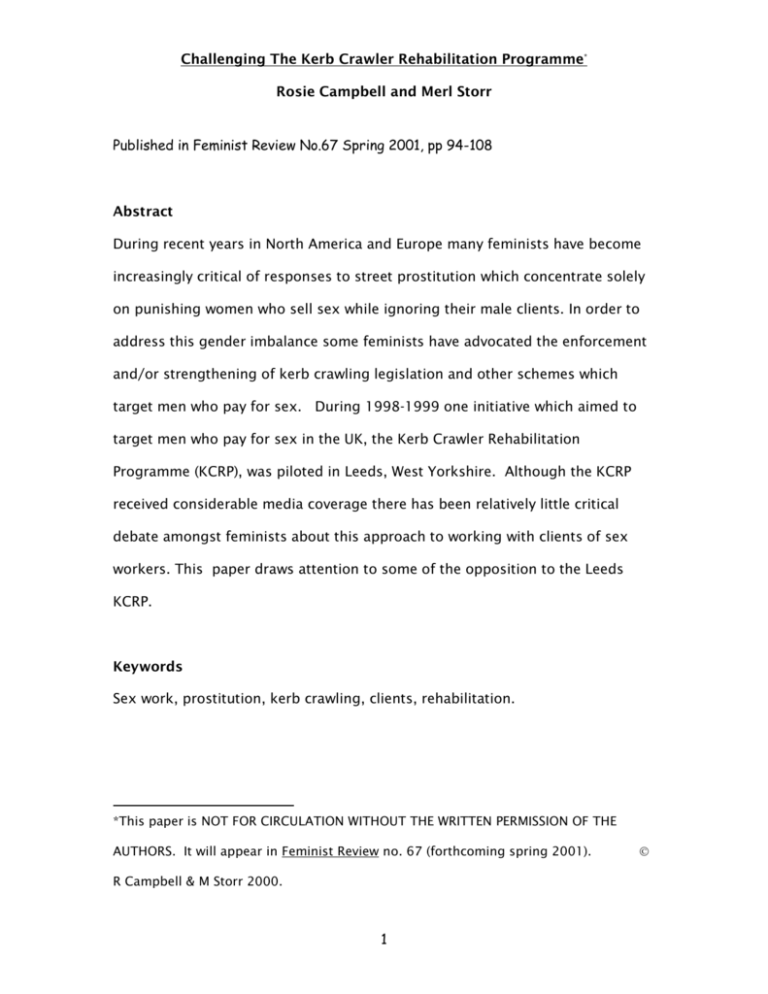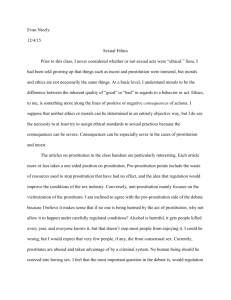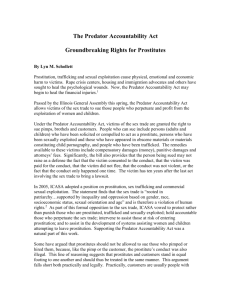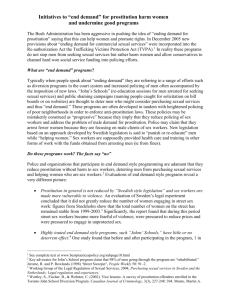
Challenging The Kerb Crawler Rehabilitation Programme*
Rosie Campbell and Merl Storr
Published in Feminist Review No.67 Spring 2001, pp 94-108
Abstract
During recent years in North America and Europe many feminists have become
increasingly critical of responses to street prostitution which concentrate solely
on punishing women who sell sex while ignoring their male clients. In order to
address this gender imbalance some feminists have advocated the enforcement
and/or strengthening of kerb crawling legislation and other schemes which
target men who pay for sex. During 1998-1999 one initiative which aimed to
target men who pay for sex in the UK, the Kerb Crawler Rehabilitation
Programme (KCRP), was piloted in Leeds, West Yorkshire. Although the KCRP
received considerable media coverage there has been relatively little critical
debate amongst feminists about this approach to working with clients of sex
workers. This paper draws attention to some of the opposition to the Leeds
KCRP.
Keywords
Sex work, prostitution, kerb crawling, clients, rehabilitation.
*This paper is NOT FOR CIRCULATION WITHOUT THE WRITTEN PERMISSION OF THE
AUTHORS. It will appear in Feminist Review no. 67 (forthcoming spring 2001).
R Campbell & M Storr 2000.
1
During recent years in the United States, Canada and some European countries
many feminists have become increasingly critical of responses to street
prostitution which concentrate solely on punishing women who sell sex while
ignoring their male clients. In order to address this gender imbalance some
feminists have advocated the enforcement and/or strengthening of kerb
crawling legislation and other schemes which target men who pay for sex.
During 1998-1999 one initiative which aimed to target men who pay for sex in
the UK, the Kerb Crawler Rehabilitation Programme (KCRP), was piloted in Leeds,
West Yorkshire. The KCRP was established as a pilot project set up by the
Research Centre for Violence, Abuse and Gender Relations at Leeds Metropolitan
University in conjunction with West Yorkshire Police. This programme intended
to shift the focus from the women who sell sex – specifically, in this case, streetworking women – to the men who pay. The programme aimed ‘to create safety
in communities by adopting a more pro-active approach to kerb crawlers
through shifting the focus from street prostitutes to the users’ (Research Centre
for Violence, Abuse and Gender Relations 1998). It was described by the
organisers as ‘... a hard hitting educational day school designed to break the
silence, secrecy and collusion surrounding men’s involvement as users of adult
and child prostitutes’ (Research Centre for Violence, Abuse and Gender
Relations 1998). Based on a North American ‘Johns School’ model, the content
and ethos of the school was informed by a radical feminist analysis which
identified all prostitution as abuse of and violence against women.
The operation of the school required police officers proactively to police street
prostitution in order to identify and gather evidence.1 Men charged with kerb
crawling offences were offered a choice between a court summons or
2
attendance at the KCRP. If they chose the latter they were required to pay an
administrative fee of £85 which would ‘cover the costs of their education’. The
programme content on the whole reflected that of the US model, consisting of a
number of presentations delivered by a range of individuals. Programme
content included: information from a police officer about current legislation;
information from a health worker about sexually transmitted diseases; a
presentation by a local resident about the effects of kerb crawling on residential
communities; an account of the impact on parents of children’s involvement in
prostitution, given by a woman whose daughter was murdered by a client; and a
talk on the ‘realities of prostitution’ given by a former prostitute whose
experiences had involved coercion and violence (Olden 1999).
Although the piloting of the KCRP received considerable media coverage, there
was relatively little critical debate amongst feminists about this approach to
working with clients of sex workers. This was despite considerable concerns
about this initiative raised both by a number of agencies working with sex
workers and by sex workers themselves. Some organisations promoting the
health and safety of sex workers expressed surprise at feminist support for the
programme: ‘Its appeal to feminists, police, and government is a mystery to
those of us who have worked for many years to promote the health, safety and
civil rights of sex workers’ (Kinnell 1999). This paper draws attention to some
of the opposition to the Leeds KCRP.
3
Taking its name from a presentation given at the ‘Sex Work Reassessed’
conference (Wilcock 1998), Cause for Concern was formed in early 1999. It was
an informal network of organisations and individuals who shared some
reservations about the Leeds KCRP and came together to raise their concerns
with policy makers and service providers. Rosie Campbell was an active
member of Cause for Concern, and we want to stress that although we are
responsible for the arguments developed in this paper many of the concerns
outlined here were first identified by Cause for Concern.
Shifting the Balance? Targeting Clients
Many policy makers, feminists, sex worker activists and resident communities
affected by street prostitution have become frustrated with the existing
‘traditional’ legal management of street prostitution in the UK. Crudely
summarised, this has involved responding to residential complaints by
enforcing the soliciting legislation which relies upon arresting, prosecuting,
fining and hence ultimately criminalizing street sex workers (Sharpe, 1998). This
triggers a ‘revolving door scenario’ whereby sex workers are then under greater
financial pressure to work in order to pay fines. Clearly, then, this approach
punishes street prostitution but does nothing to prevent it. It can also have the
effect of displacing street work elsewhere, or of dispersing it across a wider
geographical area. There is dissatisfaction on all sides of the prostitution debate
with this state of affairs, which serves neither to eradicate street prostitution nor
to improve the lot of street workers.
4
However a significant shift in focus, to include men who pay for sex as well as
women who sell sex, has recently begun. This shift has been discernible in
both North America and Europe. Perhaps most indicative of this approach are
the recent changes in legislation in Sweden, where in 1998 buying sex entered
the penal code and the purchasing of sexual services was criminalized. McElroy
(1998) refers to a ‘sea change’ in the way police authorities in the United States
and Canada address street prostitution: this has entailed a shift towards a
greater emphasis on arresting clients than was previously the case. She points
to the Canadian example of Edmonton Police Service which ‘declared 1992 the
Year of the John and concentrated on charging clients’ (p. 38). She argues that
this change was supported by anti-prostitution feminists, who argue for a
particular model of decriminalisation different from that advocated by many
prostitute activists. This model has been described as ‘decriminalisation with
the goal of abolition’, and advocates that the legal authorities should not arrest
and criminalize the women working in prostitution but only the men involved as
clients and pimps.
In the UK some police forces have also adopted a policy of policing clients as
well as sex workers to present a more gender-balanced approach and to deal
with the ‘demand’ side of prostitution (Benson and Matthews, 1995). There is
no doubt that the policing of prostitution in the UK has on the whole provided a
graphic illustration of the double standard enshrined in English law: female sex
workers are criminalized whereas their male clients are not.2 Hence one might
think that for feminists concerned with gender equality the path forward would
be clear: to equalise both the law itself and its enforcement. However this issue
is not as clear-cut as it may seem. Whilst there is no doubt that an enforcement
5
approach which targets clients as well as sex workers is more even-handed, it
does not deliver a radically different approach but rather works within and
reinforces the criminalisation of prostitution. It is doubtful whether such an
approach would see any fundamental benefits for sex workers; indeed, as we
argue below, it could exacerbate conditions for sex workers. Fundamentally
equalisation does not address a legal framework which criminalizes sex
workers, and addresses neither the issues faced by sex workers nor those of
local residential communities affected by street prostitution.
Invisible Men: Research, Interventions and Clients of Sex Workers
It is clear, then, as proponents of the KCRP themselves pointed out, that
‘traditionally everyone with an interest in prostitution – health workers,
researchers, police officers – have focused on women’ (Bindel, 1998/99).
Although the research base regarding clients of sex workers is growing
(McKeganey, N, 1994, Plumridge et al, 1997, Faugier, J and Cranfield, S, 1995,
Kinnell, H and Griffiths, R.K., 1989, Campbell, R, 1999, O’connell Davidson, J,
1998), it is still under-developed. There is great scope for feminist researchers
to learn more about clients and to develop evidence-based proposals for
positive policy interventions with this group. There is certainly a need to make
the ‘invisible men’ (Campbell 1997) involved in purchasing sex more visible
within research, academic debates and policy consideration. So perhaps one
beneficial outcome of the piloting of the KCRP was the high-profile publicity and
public debate about clients it stimulated.
6
Yet it is questionable whether the language used to describe clients in reportage
associated with the KCRP was helpful in enabling the discussion about clients to
move beyond mythology and stereotypes. For example, an article written by
one of the KCRP’s organisers appeared in The Independent newspaper under the
title ‘Out of the Gutter’; it was reprinted in Trouble and Strife with the title
‘Flushing the Johns’. This article described the KCRP participants as ‘like that
scene from Hitchcock’s movie The Birds where all the crows are silently perched
in a row, looking ahead’ (Bindell 1998). The KCRP was also covered in a
number of other articles in local and national papers. For example the Evening
Gazette (Curtis 1999), a local daily paper based in the north-east of England,
ran its story under the headline ‘Kerb-Crawlers Are Like Alley Rats, They Satisfy
their Appetites under Cover of Night and Prey on the Vulnerable…and Julie is
Out to Get Them!’
A discourse which constructs clients as dehumanised, dirty and animalistic gets
us no nearer to an informed debate about clients, and perpetuates stereotypes
which obscure the complex social, economic and cultural relationships in which
commercial sex takes place. Atkinson et al. (1998) describe how research on
clients has shifted from early work which treated the client as an abnormal
deviant, through to more recent research which locates the client within cultural,
gendered and economic relations. Much of the media discourse surrounding
the KCRP appears to takes us back to the construction of the client as an
abnormal deviant.
7
In the light of research indicating enduring pressures from clients for unsafe sex
and enduring violence against street workers, a number of researchers have
suggested interventions with clients which address issues of respect for
prostitutes and prostitutes’ rights (e.g. McCullagh 1998). Sex workers may
welcome interventions with clients which attempt to address issues of
importance to them. Certainly the views of one Leeds street sex worker
opposed to the KCRP indicates that this is the case:
It is not the concept of the programme that appals me as I would wave
my arms in the air and cheer if they came up with a programme that
taught men to respect working women. A programme that dealt with
problems in prostitution like rape and murder, violent assaults, pimps
and negative attitudes towards women who work in prostitution would be
welcomed, I am sure, by other working women. A programme that
taught clients about the problems women face and a true picture of
sexual health is what is really needed.
(Julia, cited in Taylor 1999)
These are the views of one sex worker: Julia’s position may or may not be
representative of street sex workers. What is clear is that feminist researchers
need to consult sex workers widely about the types of interventions they feel
would be useful.
8
O’Neill et al. (1994) stress the importance of including sex workers in debates
about policy development. They emphasise the need to listen to and include
women’s experiences and voices, and they advocate woman-centred, multiagency responses which include sex workers in developing policy and services.
But in the development of the KCRP there appeared to have been only limited
consultation with women who sell sex on the streets, or with the projects
working with them. A crucial lesson for feminists to consider when involving
themselves in policy development is the potential impact of policy on sex
workers and the need to consult sex workers about their own needs and views.
Initiatives which treat sex workers as objects of concern rather than as subjects
– no matter how well intentioned – sit uneasily with feminist politics.
Policing and Sex Worker Safety
Projects such as the KCRP rely on the allocation of significant policing resources
to the ongoing targeting of clients in order to ‘recruit’ clients into the school.3
Even if the focus is shifted to clients, the active policing of street prostitution
has a number of implications for the safety and welfare of street workers
themselves.
Firstly it is crucial to point out that although a police force may decide to have a
police operation that primarily targets clients, this does not give an amnesty to
sex workers themselves. Hence police operations which proactively target
clients usually involve the ongoing policing of female soliciting. More intensive
policing operations mean that women are more likely to work in more isolated,
unfamiliar and unsafe areas to avoid police surveillance and arrest. There may
even be increased migration between ‘beats’ in different cities and towns where
9
women are less familiar with the scene and with the ‘dodgy punters’ in that
area. Such patterns have been found in other cities where intensive police
actions are enacted (Campbell and Hancock 1998).
If there is an awareness that the police are looking for evidence of kerb
crawling, the client and sex worker will be under pressure to ensure that the
solicitation negotiation is as short as possible. Indeed numerous researchers
have commented on this effect of contemporary legislation (e.g. Barnard 1993):
that the limited time sex workers have to ‘suss’ out clients and put in place
safety strategies is further eroded.
One objective of the KCRP was to reduce the client base: the argument was that
without demand there would be no supply. So what does a reduced client base
mean for street sex workers? Fewer clients means women have to work
extended hours to earn the sums of money they require for their subsistence
(which may include drug use). Increased competition for clients between sex
workers means prices are depressed. There is likely to be a shift to later hours
of working, to avoid police and to make contact with clients. This may also be
combined with earlier hours of working in order to tap into a broader market of
clients; earlier working in day time hours can create more conflict with
residents. This Leeds street worker describes what she sees as the direct
negative impact of the policing attached to the KCRP initiative on the context in
which she sells sex:
It used to be £20 for straight sex in a car but now the going rate is £10. I
used to be out from 7-10.30 p.m. and could earn £130. Now I can be out
10
from 5 p.m. until midnight and I might go home with just £40. It’s too
easy for men to get caught on the well-lit main roads now, so we’re
forced into dark side streets where we can’t take number plates or get a
good look at a client before we decide whether or not he is safe to get in
the car with. And there’s a lot of tension and hostility between the
women that just wasn’t there before.
(Julia, quoted in Taylor 1999)
In any case it is debatable is whether supply would actually cease. The KCRP did
not address the socio-economic factors which shape the entry of many women
into street prostitution. The introduction of the programme was not
accompanied by a parallel investment in services for women who are involved in
and/or wish to leave prostitution. As Cause for Concern argued:
If the KCRP does as it aims reduce the number of clients, then the women
who serviced these clients do not go away, they remain with the
motivations they had before for selling sex. Such reasons may include
amongst other things: poverty, debt, drug use and coercive pimps. With a
reduced client base and no alternative income we would expect to see an
increase in women earning money from other illegal activities such as
shoplifting, and other activities which have greater penalties attached,
including imprisonment.
(Cause for Concern 1999)
Street working prostitutes are often those with fewest options in terms of
employment in other areas of the sex industry or in other jobs or education.
11
Cause for Concern felt that ‘Targeting their clients further erodes their
livelihood and further serves to marginalise them’, and that a potential impact
of the KCRP was therefore ‘to contribute further to their hardship’ (Cause for
Concern 1999).
Impact on Sexual Health: A Risky Business
A growing body of UK research examining safer sexual practices amongst sex
workers indicates that in commercial sex encounters rates of condom use are
high (McKeganey & Barnard, 1992; Morgan Thomas et al, 1989; Faugier et al,
1992; Blakey & Frankland, 1995; Ward et al, 1993, McCullagh et al, 1998). Yet
research shows that with greater competition for clients and no alternative
income, women are more likely to accept less money and take greater risks in
terms of their personal safety and sexual health. McCullagh (1998) notes the
socio-economic context in which street prostitution takes place and the factors
which shape sex workers’ power to insist on safe sex:
For most street prostitutes, payment is based on the number of sexual
acts provided and consequently earnings depend upon how quickly
clients can be found and services given. Drug withdrawal, poor weather
conditions, the level of policing, and violence on the street may all create
pressures to finish work quickly and accept greater financial inducement
to provide unprotected sex.
(McCullagh 1998)
12
The pressures reduce women’s power to negotiate safer sex and hence they are
more likely to sell unprotected sex. Initiatives targeting clients add another
factor into this already difficult environment and create conditions where the
pressures to take risks are heightened. Fewer clients mean greater competition
between sex workers: this undermines sex worker power in negotiations with
clients. In such a climate women may be more likely to ‘take risks’ in terms of
condom use and other safe sex practices. Wilcock (1998) found that amongst
those sex workers who disclosed that they had not used condoms, ‘desperation
for money and lack of clients were cited as the main reasons for not using
condoms’ (Wilcock, 1998: 63). This would suggest that ‘initiatives which aim to
reduce client numbers by intensive policing and client arrest, and which do not
make any other provision to meet sex workers’ needs, carry serious health and
safety implications’ (Wilcock, 1998: 63-64).
Challenging Violent Clients?
The high levels of violence faced by street sex workers have been widely noted
(McKeganey and Barnard 1996; Pearce 1997; O’Neill 1995 ). Such research
indicates that only a minority of violent offences experienced by sex workers are
reported to the police (McKeganey and Barnard 1995; Barnard 1993; Kinnell
1993). Developing a policing approach and other policies which address the
safety of sex workers is clearly a pressing priority. There has been considerable
interest in the KCRP from the Home Office in this respect. The initiative is
identified in Living without Fear, the first UK national strategy document on
violence against women, as an example of good practice in relation to sex
offender programmes which aim to reduce sexual re-offending.
13
However there is no clear evidence that the programme reduced violence
against sex workers or had any impact on violent clients. Men who came to the
KCRP had committed kerb crawling offences: they were not necessarily
perpetrators of violence against sex workers. Whether the men who attended
the school had been or would be violent towards sex workers was not known
(Wilcock 1998). Indeed the programme made it clear that it would not deal with
men who were known to have committed violent offences. There is no evidence
that all men who pay for sex will all be or will become violent and abusive
towards sex workers. Such a ‘scatter gun’ approach only makes sense in a
ideological framework in which all clients are treated as abusers. It does not
allow for differences between clients in terms of their attitude towards and
interaction with sex workers.
The KCRP pilot programme did not appear to be part of a broader co-ordinated
strategy to tackle violence against street sex workers, to improve liaison
between sex workers, the police and projects working with them, or actively to
encourage the reporting of violent incidents. Nor did it appear to be tied in with
any other practical initiatives to improve the safety of street workers. The
diversion of police and other resources to initiatives aimed at preventing
violence against sex workers and to prosecuting those who commit violent
offences should clearly be a priority. For example the development of sensitive
and constructive prostitute police liaison which aims to encourage and support
women to report violent assaults against them has been advocated as a
potential way of demonstrating that women’s reports will be taken seriously
and proactively encouraging reporting (May et al. 1999; Campbell et al. 1996).
14
At present in the UK there is no national ‘ugly mugs scheme’ listing ‘dodgy
punters’ which sex workers or projects can access, nor is there a national police
database of violent clients and incidents against sex workers. Projects which
target clients indiscriminately do not address these issues, nor do they
necessarily move us any further towards better and safer working conditions for
sex workers.
Indeed Wilcock (1998) and Cause for Concern (1999) raised the possibility that
the programme may actually have deterred those clients who were least likely to
be violent. The men who had less to lose through exposure and who made
possibly the most dangerous and erratic clients were precisely those with whom
the KCRP refused to work work. Similar concerns have been raised by women
involved in prostitution in North America. In the context of the Johns Schools in
the USA McElroy notes;
The dozens of prostitutes I’ve spoken with are appalled by the
development. One of their arguments is that the Johns School is making
the streets less safe for prostitutes. The force of such laws will not
determine, and historically has never determined, how many women have
turned to the streets. But, prostitute activists argue, the laws will
discourage a certain class of men from seeking out streetwalkers. Men
who are married, with respectable careers and a reputation to protect,
will not risk being publicly exposed as a john. On the other hand men
who are criminally inclined towards prostitution will not be discouraged
by the prospect of a police fine. Thus police/feminist policy keeps
peaceful johns off the streets and leaves women to compete more
15
vigorously for johns and screen less rigorously those who approach
them. Is it any wonder that violence against street walkers is rising in
many North American cities?
(McElroy 1998: 338)
Conclusion: Short-Circuited Thinking
The following comment from a Japanese feminist raises a dilemma which many
feminists face when their attention is turned to men who pay for sex:
Japan’s Prostitution Prevention Law says that, in principle, selling sex is
illegal, but the seller doesn’t get punished unless she promotes it
publicly. I wonder if it’s possible to punish the buyer but not the seller.
True, it is a big problem that the buying side hasn’t been questioned, and
it makes me angry too. Still, won’t it be kind of short-circuited thinking
to propose to punish the buying side to correct that omission?
(Group Sisterhood 1998: 94)
This reflects some of the ambivalence towards clients and towards policies
which focus on the ‘demand’ side of prostitution which many feminists
confronting male clients may experience. It also raises the issue that policies
and initiatives which further ‘punish’ the buying side of commercial sex do not
necessarily improve things for women involved in prostitution. They are indeed
examples of ‘short-circuited thinking’.
Such dilemmas have been raised by the piloting of the Kerb Crawler
Rehabilitation Programme. In the light of the appearance of this initiative in the
16
UK and of a broader policy shift throughout Europe to consider punishing male
clients, it is important that there should be discussion amongst feminists about
the implications of such an approach and that this debate not take place in a
vacuum devoid of the views and perspectives of sex workers themselves.
Existing research has demonstrated a need to develop specific interventions
with male clients in the UK which address respect for sex workers and their
rights. More broadly strategies and legislative changes are needed which
respond more effectively to the violence experienced by street workers from
clients and others.
Legislation which aims to further criminalize men who pay for sex with adult sex
workers and other interventions which aim to ‘punish’ male clients do not
present, as they might at first appear to do, a progressive way forward for
feminists and others concerned about improving the rights of women involved
in prostitution.4 In the UK context such policies leave untouched an
unsatisfactory legislative framework which undermines the safety and welfare
of street sex workers and serves to reinforce the criminal status and hence
social stigma associated with sex work. Indeed initiatives such as the KCRP and
the associated active policing of street prostitution have the potential to worsen
the safety and welfare of women involved in street prostitution, and the most
vulnerable women will bear the brunt:
Indeed, kerb crawling legislation … can actually make the most
vulnerable prostitutes even more vulnerable. It increases the pressure on
prostitutes to negotiate quickly, for example, or to get into clients’ cars
17
and so off the street before they have negotiated a deal, both of which
reduce the prostitute’s control over the situation.
(O’Connell-Davidson 1998: 199)
In direct response to criticism of the programme organisers of the school have
clarified their aims:
The KCRP never ‘promised to help sex workers’ by taking punters off the
street, but to offer the men an opportunity to become more enlightened
about the realities of prostitution. The aim is to get men off the streets
and shift the focus from the women as the problem
(Bindel 1999)
Of course the appeal to some feminists of initiatives such as the KCRP can be
understood, particularly in the light of feminist analyses which identify
prostitution as a form of violence against women. Certainly, as O’Connell
Davidson writes:
To the extent that such moves reflect a growing discomfort with the legal
harassment of prostitutes and the hypocrisy and sexism inherent in
traditional prostitution law and law-enforcement practice, they are to be
welcomed. But, unless meaningful steps to address the structures that
drive people into prostitution are simultaneously taken, legal and other
measures aimed at preventing prostitute use will do little to improve the
lot of those who are exploited by prostitute users.
(O’Connell Davidson 1998: 199)
18
Whatever particular analysis of prostitution feminists favour, feminism is
fundamentally about improving social and economic conditions for women.
This includes raising issues of violence against women and shaping effective
policies to address such violence. Priorities for feminists involved in informing
prostitution policy should therefore include: challenging negative attitudes
towards sex workers; enabling the views, experiences and voices of sex workers
to be heard in all their diversity; challenging violence against sex workers; and
ensuring that policy development grows out of an inclusive process which
consults all groups involved and affected by prostitution – including sex
workers themselves, who are too often marginalised in the policy arena
(Campbell and Hancock 1998). There should be no place in feminist politics for
interventions which merely increase the daily risks and pressures faced by
street-working women.
REFERENCES
ATKINSON, Chris, FRASER, Laura and LOWMAN, John (1998) ‘Men Who Buy Sex:
Preliminary Findings of an Exploratory Study’, in ELIAS (1998)
BARNARD, Marina (1993) ‘Violence and Vulnerability: Conditions of Work For
Streetworking Prostitutes’, Sociology of Health and Illness, Vol. 15, No. 5: 683705.
19
BARNARD, Marina, MCKEGANEY, Neil and LEYLAND, A (1993) ‘Risk Behaviours
Among Male Clients of Female Street Prostitutes’, British Medical Journal, Vol.
307: 361-362.
BENSON, C and MATTHEWS, R (1995) National Vice Squad Survey,
Middlesex University.
BINDEL, Julie (1999) Letter in ‘Streets Apart On Approach to Kerb Crawling’, The
Guardian, 18th August.
BINDEL, Julie (1998) ‘Flushing the Johns’, Trouble and Strife, No. 38: 35-36.
BINDEL, Julie (1998) ‘Out of the Gutter’, The Independent, 12th November.
CAMPBELL, Rosie (1997) ‘“It’s Just Business. It’s Just Sex”: Male Clients of Female
Prostitutes in Liverpool’, Journal of Contemporary Health, Vol. ? No.5: 47-51.
CAMPBELL, Rosie (1998) ‘Making Visible Male Clients of Female Prostitutes in
Merseyside’, in ELIAS (1998)
CAMPBELL, Rosie, COLEMAN, Sheila, TORKINGTON, Protashia (1996) Street
Prostitution in Inner City Liverpool, Liverpool City Council.
CAUSE FOR CONCERN (1999) ‘Kerb Crawler Rehabilitation Programme: List of
Concerns’, EUROPAP UK.
CURTIS, Denise (1999) ‘Kerb Crawlers are Like Alley Rats, they Satisfy their
Appetites Under Cover of Night and Prey on the Vulnerable: And Julie is Out to
Get them!’, Evening Gazette, May 24th.
DAY, Sophie and WARD, Helen (1990) ‘The Praed Street Project’, in PLANT
(1990).
DAY, Sophie, WARD, Helen and PERROTTA, L (1993) ‘Prostitution and HIV: Male
Partners of Female Prostitutes’, British Medical Journal, Vol. 307: 359-361.
EDWARDS, Susan (1997) ‘The legal regulation of prostitution: a human rights
issue’, in SCAMBLER & SCAMBLER (1997).
20
ELIAS, N (1998) editor, Whores, Hustlers and Johns, Prometheus Press, New
York.
ELLICOT, Susan (1999) ‘Shock Tactics for Kerb Crawlers’, The Times, May 10th.
FAUGIER, Jean and CRANFIELD, S (1995) ‘Researching Male Clients of Female
Prostitutes: The Challenge for HIV Prevention’, Aids Care, Vol. 7: 1.
FAUGIER, J., HAYES, C. and BUTTERWORTH, C (1992) ‘Drug Using Prostitutes,
Their Health Care Needs and Their Clients’, University of Manchester.
GROUP SISTERHOOD (1998) ‘Prostitution, Stigma, and the Law in Japan: A
Feminist Round Table Discussion’, in KEMPADOO, K and DOEZEMA, J (1998).
HOIGARD, C and FINSTAD, L (1992) Backstreets: Prostitution, Money and Love,
Polity, Cambridge.
HOME OFFICE (1999) Living Without Fear: An Integrated Approach To Tackling
Violence Against Women, Home Office/Cabinet Office, London.
HUBBARD, Phillip (1999) Sex and the City: Geographies of Prostitution in the
Urban West, Ashgate, Aldershot.
JOHNSON, A., WADSWORTH, J, WELLINGS, K and FIELD, J (1994) Sexual Attitudes
and Lifestyles, Blackwell, Oxford.
KEMPADOO, K and DOEZEMA, J (1998) editors, Global Sex Workers: Rights,
Resistance, and Redefinition, London, Routledge.
KINNELL, Hilary (1989) ‘Prostitutes, their clients and risks of HIV infection in
Birmingham’, Occasional Paper, Birmingham Department of Public Health.
KINNELL, Hilary and GRIFFITHS, R.K. (1989) ‘Male Clients of Female Prostitutes in
Birmingham England: A Bridge for Transmission of HIV?’, Department of Public
Health, Central Birmingham Health Authority.
21
KINNELL, Hilary (1993) ‘Prostitutes Exposure to Rape: Implications for HIV
Prevention and for Legal Reform’, paper presented to the VII Social Aspects of
AIDS Conference, June.
KINNELL, Hilary (1999) letter in ‘Streets Apart On Approach to Kerb Crawling,
The Guardian, 18th August.
LEONARD, T (1990) ‘Male Clients of Female Street Prostitutes: Unseen Partners
in Sexual Disease’, Medical Anthropology Quarterly, Vol. 4:1 41-55.
MAY, Tiggy et al (1999) Drugs and Sex Markets, Home Office, London.
MARLOWE, Julian (1996) What’s Wrong With John School?,
MILLS, Heather (1999) Title? The Observer, 7th March.
McCLEOD, Eileen (1982) Women Working: Prostitution Now, Croom Helm,
London.
McELROY, Wendy (1998) ‘Prostitutes, Anti-Pro Feminists and the Economic
Associates of Whores’, in ELIAS (1998).
McCULLAGH, Jo, SYED, Qutub and BELLIS, Mark (1998) ‘Female Prostitution and
Associated Drug Use in the North West of England’, Changing Perspectives on
Female Prostitution: Conference Proceedings, Liverpool.
McKEGANEY, Neil (1994) ‘Why Do Men Buy Sex and What are their Assessments
of the HIV-Related Risks When They Do?’ AIDS Care, Vol. 6 No. 3: 289-301.
McKEGANEY, Neil (1995) ‘Prostitutes and Violence: A Neglected Public Health
Issue’ in Women and Substance Misuse, Conference Report, Brighton.
McKEGANEY, Neil (1996) ‘Sex in the Shadowlands’, Guardian, May 29th.
McKEGANEY, Neil and BARNARD, Marina (1996) Sex Work on the Streets:
Prostitutes and their Clients, Open University Press, Buckingham.
22
MILLER, Jackie (1993) ‘Your Life is on the Line Every Night You’re on the Streets:
Victimization and the Resistance Among Street Prostitutes’, Humanity and
Society, Vol. 17, No. 4: 422-446.
MOORE, Susan (1999) ‘Characteristics, Attitudes and Risk Behaviours of
Australian Men Who Visit Female Sex Workers’, Venereology, Vol. 12, No. 1: 814.
O’CONNELL DAVIDSON, Julia (1998) Prostitution Power and Freedom, Polity
Press, Cambridge.
OLDEN, M (1999) ‘School for Scandal Confronts Kerb Crawlers with Their
Shame’, The Big Issue in the North.
O’NEILL, Maggie (1995) ‘Prostitution and Violence: Towards a Feminist Praxis’ in
RADFORD et al (1995).
O’NEILL, Maggie, JOHNSON, Sue, MCDONALD, Mo and MCGREGOR, Helen (1994)
‘Prostitution, Feminism and the Law: Feminist Ways of Seeing, Knowing and
Working With women Working as Prostitutes’, Rights of Women Bulletin,
Autumn/Winter.
PEARCE, Jenny (1997) Prostitution and Drugs in Sheffield: Exploring the Links,
Middlesex University.
PLANT, M (1990) editor, AIDS, Drugs and Prostitution, Routledge, London.
PLUMRIDGE, Elizabeth, CHETWYND, Jane, REED, Anna and GIFFORD, Sandra
(1997) ‘Discourses of Emotionality in Commercial Sex: The Missing Client Voice’,
Feminism and Psychology, Vol. 7, no. 2: 165-181.
RADFORD, G, HESTER, R, and KELLY, L (1995) editors, Women, Violence and
Male Power: Feminist Activism, Research and Practice, Open University Press,
Oxford.
23
RESEARCH CENTRE ON VIOLENCE ABUSE AND GENDER RELATIONS (1998)
‘Outline’, Leeds Metropolitan University.
SANTOS ORTIZ, M.C, LAO-MELENDEZ, J.L and TORRES-SANCHEZ, A (1998) ‘Sex
Workers and the Elderly Male Client’, in ELIAS, N (1998)
SCAMBLER, Graham, and SCAMBLER, Annette (1997) editors, Rethinking
Prostitution: Purchasing Sex in the 1990s, London, Routledge.
SHARPE, Karen (1998) Red Light, Blue Light: Prostitutes , Punters and Police,
Ashgate, Aldershot.
SULLIVAN, Elroy and SIMON, William Simon (1998) ‘The Client: A Social,
Psychological and Behavioural Look at The Unseen Patron of Prostitution’, in
ELIAS (1998).
TAYLOR, Diane (1999) ‘Street fighters’, The Guardian 17th August
WILCOCK, Steph (1998) The Lifeline Sexwork Project Report: Occupational
Health and Safety Issues and Drug Using Patterns of Current Sexworker: Survey
Findings, Lifeline, Manchester.
WILCOCK, Steph (1998) ‘John School: Cause for Concern and Inappropriate
Proposal for the UK?’, presented at Sex Work Reassessed: A National
Conference, 9th September, University of East London.
NOTES
Rosie Campbell is a Senior Researcher in the Applied Research Centre at
Liverpool Hope University College. She has been involved in carrying out action
research on sex work in Merseyside and the West Midlands since 1995. She is
presently Co-ordinator of the EUROPAP Safety, Violence and Policing Working
Group.
24
Merl Storr is Senior Lecturer in Sociology at the University of East London and
was one of the co-organisers of the conference Sex Work Reassessed. Her
current research interests are in the retail sector of the sex industry.
1
In the UK it is not an offence to buy sexual services. Section 1 of the Sexual Offences
Act 1985 makes it an offence for a man to solicit ‘a woman (or different women) for the
purposes of prostitution;
(a) from a motor vehicle while it is in a street or public place, or
(b) in a street or public place while in the immediate vicinity of a motor vehicle that he
has just got out of or off, ….. persistently or in such a manner or in such circumstances
as to be likely to cause annoyance to the woman (or any of the women) solicited, or
nuisance to other persons in the neighbourhood’. There is no power of arrest for this
offence: the act requires summary conviction only.
2
Almost all prostitution laws in England and Wales apply to female prostitutes only.
Male prostitution is regarded by the law as a matter of homosexuality rather than of
prostitution, and is dealt with separately. The highly gendered nature of this legislation
has been the target of considerable feminist criticism: see e.g. Edwards (1997).
3
Indeed at the time of writing (July 2000) the Kerb Crawling Rehabilitation Programme
was not being run in the UK. In West Yorkshire the police had ceased to support the
initiative, their key reason being that they could not sustain the level of resource input
required.
4
This dialogue is focusing on debates about clients of adult sex workers and not
debates about men involved in the commercial sexual exploitation of children.
25








